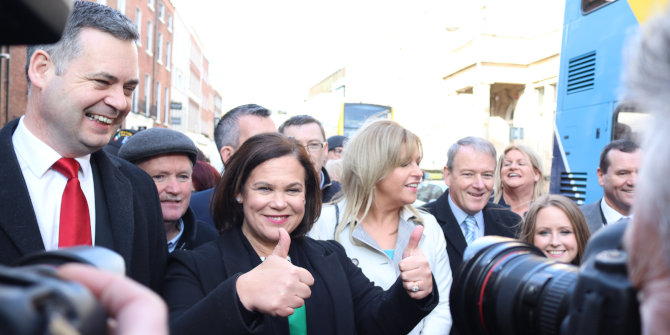For many months now support for Sinn Féin in the South has been elevated in opinion polls, reaching as high as 35% and raising the prospect of it leading the next government with Mary Lou McDonald as Taoiseach. Posed by some as the start of a historic transition, Kevin McLoughlin assesses whether Sinn Féin will realise this potential, and if it does assume power in the next two or three years, will Ireland really be changed North and South.
What’s behind the surge in the polls
Recent articles on Sinn Féin have contrasted how it won its first, and at the time only, TD in Cavan / Monaghan in 1997 with Caoimhghín Ó Caoláin, but just 25 years on it is preparing for power. The recent turn around is actually even more dramatic given that in the 2019 local elections Sinn Féin’s vote declined by more than 37%, and it lost half its seats. Yet in the General Election just nine months later it became the biggest party in the state, increasing its vote from the previous General Election by an incredible 77%.
The local elections were a sullen, angry affair. Not seen as very important, this allowed for more variable results and in 2019 the opposition and the left, weakened by the decline of the mass anti-austerity movement of a few years earlier, were the ones to feel the chill of people’s disappointments. But a General Election concentrates the mind, and the fundamental shift away from the establishment parties which were responsible for the non-recovery in the majority of people’s economic circumstances, reasserted itself in 2020 and did so dramatically through the biggest opposition party: Sinn Féin.
The process had similarities to the rise of Syriza, the main left party in Greece up until 2015. In the 2009 legislative elections, Syriza received just 4.6% of the vote. However, the Great Recession devastated Greek society, and people searched for an alternative and a way to strike back at the attacks from the Greek establishment and the Troika, and propelled Syriza to power within a few years.
“When we ask people why they vote for Sinn Féin the dominant reason is that they want a change from Fianna Fail and Fine Gael. Very few people cite anything that the party or its leader is promoting.” So said Kevin Cunningham of Ireland Thinks polling.1
While it is correct that the motor for the momentum comes from a desire to get rid of the establishment parties and the housing, health and cost-of-living crises they are responsible for, in the last General Election Sinn Féin did lean somewhat to the left and its messaging had an impact. With the Government likely to be beset with intractable problems, Sinn Féin’s performance in opposition could see its polling increase consistently.
Sinn Féin outpolling Fianna Fáil and Fine Gael itself became a turning point and has changed how people perceive the political situation here and the possibilities. This result provoked comment by media around the world, but it has penetrated broad consciousness around Ireland and clearly is a factor in Sinn Féin’s rise in the polls since.
Broadening base of support
Sinn Féin has increased its support far beyond working-class areas and among younger voters, with one poll in December indicating that it got 27% of the middle-class vote, more than any other party. This growth in middle-class support is taking place at precisely the same time as Fine Gael’s support shows a consistent decline over the last year. The two parties were vying with each other, with ratings in the late-20s between March and April last year, but since then Sinn Féin has gone up and Fine Gael down.
Clearly, discontent and frustration with Covid is an important context. The Irish Times in December commented on this shift among the middle class, with Damien Loscher writing, “This apparent contradiction could make sense if we assume Ireland has moved from being a country obsessed with creating wealth to one concerned with how wealth is distributed.”2 The significance of this is summed up in the fact that in earlier elections Sinn Féin habitually received around 3% of middle-class votes.
Middle-class opinion has swung different ways over the last decade. In the early years of the Great Recession, up to the mid-2010s, many opposed austerity and supported the broad movements against it, notably the mass movement against the water charges. However, there was a shift in this radical mood and a fear of instability, and the emergence of a left-moving protest movement affected some. Varadkar in particular leaned on this to steady the ship after the haplessness of Enda Kenny. In a further twist, it now seems that the combination of the promised economic “recovery” not really delivering, and then the impact of Covid on consciousness – with all the uncertainty it brought – may have shaken the confidence in progress of middle layers and shifted them again towards the need for political change.
A coronation or a dirty battle?
The shift towards Sinn Féin has been consistent since the last General Election and naturally this gives credence to the prospect of it winning the next election and a leading position in Government. However, on the basis of current poll numbers, if there were an election now Fianna Fail and Fine Gael together would still have more seats than Sinn Féin, and so could find it easier to form a government. Most importantly, the age we are in is characterised by volatility and change, as shown by the middle-class opinion shift, and so rather than a coronation we could see new twists and a particularly vicious political battle over the next few years is likely. But are there circumstances in which Sinn Féin could plateau or be knocked back from its current high?
Notwithstanding the neck and stupidity of Junior Minister Sean Fleming – lecturing people to shop around to avoid the cost of living crisis while he’s on more than €150,000 a year himself, thank you very much – the Government, as it did with the pandemic, has moved to make some concessions. While the measures won’t be enough to compensate people for the price rises, the fact that such measures were taken in the first place is a sign of a changed political dynamic.
It is not beyond the bounds of possibility that even this rightwing Government could adopt more “populist” measures in the run in to the next election, ones that might compete with the commitments that Sinn Féin has given the electorate. In the context of the Covid economic rebound it has also said it is prepared to run up budget deficits for the next number of years. So undoubtedly Fianna Fáil, Fine Gael and the Greens (who Sinn Féin says it is targeting) will try to fight, in particular to recapture middle-class support, though the health of the economy in two years time may undermine such plans.
Alternatively, by its own hand, could Sinn Féin undermine its own momentum? The Sinn Féin leadership has stated many times that it has learnt the lessons of Labour’s ignominious collapse when it was last in power; the lesson supposedly being don’t promise too much while in opposition! In general this is still Sinn Féin’s approach. It is not really promising radical change, apart perhaps from the rhetoric sometimes used to describe what it asserts would miraculously flow economically, socially and politically from Irish unity. Yes, it attacks Fianna Fail and Fine Gael strongly, but rather than positing that it would fundamentally transform Ireland, it says it would do a better job than they do, and in particular that people would feel it in their pockets on the basis of some relatively minor changes, particularly to tax policies.
In the 2011 General Election, Labour received 19.5% of the vote. But just months before, in June 2010 it was polling at 32%. The truth is that the closer it got to the election, Labour under Eamon Gilmore shifted to the right in policy and tone, and people noticed and support diminished as doubt and disappointment set in. If Sinn Féin takes a similar approach, particularly in the face of a more “populist” approach by the Government, it could plateau or decline. On the other hand, under pressure Sinn Féin might go further and adopt its own “left” variant of populism to try to ensure victory, but in doing so it would be throwing the lesson it supposedly learnt from Labour out the window.
It is possible that the Government could win back some support. Varadkar will definitely battle for the middle-class vote, particularly when he becomes Taoiseach later this year. But the broader dynamic is against the traditional establishment parties here and internationally. And while they may adopt some measures, on all key issues — housing, health and climate — its policies are rooted in a particularly right-wing, neo-liberal approach and it will not be able to resolve the problems. So it is likely that at a certain point the election will be Sinn Féin’s to lose. Sinn Féin could rise further in the polls, even reaching a point where its support is higher than the combined support for Fianna Fail and Fine Gael, which itself would further undermine the administration.
Sinn Féin is engaged in a balancing act. It needs to increase its popular vote, and intends to stand more than 80 candidates in the next General Election, having stood only 42 in 2020. At the same time, and fundamental for it, it also needs to indicate clearly to the business establishment and the markets that their interests will be safe in its hands. Sinn Féin wants to give the impression of changing and maintaining the status quo at the same time, while in reality it moves to the right and a fuller embrace of the capitalist system.
Real change or managing capitalism better?
British Labour peer Andrew Adonis attended Sinn Féin’s Ard Fheis last October, and observed the following: “You can see a political revolution taking place before your eyes. This is going to sound like an amazing thing to say but it is true, the thirst for power and the discipline behind the leader to win power reminded me of New Labour in the 1990s.”3 For working-class people the comparison is an unintended warning.
Sinn Féin’s preparation for power was also evident in the Ard Fheis vote to drop its opposition to the non-jury Specialist Criminal Court and the Emergency Powers Act. This was both an appeasement to the Irish State (sold on the basis of the need to fight organised crime), but it was also removing a stick that Fianna Fail and Fine Gael have used to try to beat Sinn Féin with in the past. It is significant, however, that Sinn Féin is willing to dispense with “core” beliefs like opposition to non-jury courts.
The business establishment is monitoring the situation. Former Fine Gael Minister and MEP, Brian Hayes, now CEO of Banking & Payments Federation of Ireland, has said, “People need to be relaxed about this. With Sinn Féin, it’s all about what a programme for government says. Manifestos are one thing, but programmes for government are a different animal.”4 And in an interview with the Irish Independent last October, when speaking about big business and investors, Sinn Féin finance spokesperson Pearse Doherty said explicitly: “They know that Sinn Féin isn’t going to go after them”.5
In power during economic turmoil?
The social and economic backdrop in which Sinn Féin may come to power will not be one of stability. Yes there is a Covid economic rebound, but only because of pent up demand and the massive stimulus the Government has pumped in, around €50 billion by now. The political establishment’s policy of inviting multinationals in the hope that this would transform the domestic economy hasn’t worked. While there’s obviously a number of well-paid jobs, which is good for those that have them, as well as corporate tax revenues (though nothing compared to what they should have paid), the real effect of the foreign-owned sector to boosting demand in Ireland via wages, buying supplies and materials and spending their profits, is limited.
The domestic Irish economy hasn’t fundamentally overcome its inherited weaknesses, notwithstanding the “Celtic Tiger” effect, and this is reflected in the generally poor provisions of essential social and public services which fall far below what is needed, and standard in much of the EU.
Ireland could continue as is if the world economy moves forward, but in fact it is weakening. The war in Ukraine and serious military tensions around Taiwan are a reflection of the global capitalist crisis and the intensification of competition between imperialist powers. All this points towards Ireland and a potential Sinn Féin government experiencing a challenging economic position.
While it is possible, but far from guaranteed, that Sinn Féin could run the country somewhat “better” than the traditional capitalist establishment, it is clear from Sinn Féin’s many policy documents that it will essentially follow the logic of the market system, leaving control and ownership of wealth, resources and industry in the hands of big business interests; meaning it simply won’t have the power to transform people’s lives.
Sinn Féin puts emphasis on taxation policy as a way of bringing change. However, even here nothing radical is being proposed. Last October Pearse Doherty said, “We are a party that believes there needs to be a competitive edge in relation to taxation in this state and that needs to be continued”.6 This means that regardless of the limited tax increases they would implement on high incomes, fundamentally Sinn Féin will continue with the neo-liberal model of a low corporate tax regime — one that necessarily undermines the provision of decent public services.
Last September, in response to the passing of a referendum in Berlin that called for the seizing of portfolios of corporate landlords to help fight the housing crisis, Sinn Féin’s housing spokesperson Eoin O’Broin was decidedly negative about such an approach. In The Journal, having explained that under Irish law if a Government wants to use Compulsory Purchase Orders (CPOs) to buy “recently built residential developments” it would have to pay “full market value”, he went on to say: “I don’t think the State needs to do that. I think we have other options that allow us to deliver much larger volumes of affordable homes at a more cost-effective way.”7 Clearly, for O’Broin and Sinn Féin, no consideration has been given to the idea that a democratically elected Government could or should challenge such pro-big business laws, and the right of profiteers to exploit such a human need.
Notwithstanding this, the housing crisis is likely to be a key issue that will mobilise people to vote for Sinn Féin. At the same time there are questions over the ability of Sinn Féin to deliver 100,000 homes over a five-year period at the estimated costs it has outlined, primarily because its plan relies on the current batch of private property developers to build them, as opposed to establishing a state-owned building company directly employing building workers, which would be able to build at cost price. A hundred thousand homes over five years is also likely a significant underestimate of the amount of homes that will be needed.
If or when Sinn Féin forms a Government, possibly with Fianna Fail, or the likes of Social Democrats or Labour, there will undoubtedly be a honeymoon period, and it can last for a while as there will be a lot of hopes that it will make a difference. During such a honeymoon people will cheer any changes delivered and go out of their way to give Sinn Féin ‘the benefit of the doubt’ on different issues that may come up.
Over time, however, it is inevitable that disappointment will set in. People will vote for Sinn Féin hoping for meaningful economic and social change but that will flounder on its innately conservative approach. In the event of global economic turmoil, the political approach that Sinn Féin adopts under pressure from its base could face it with a choice similar to Syriza in Greece: do you impose policies that attack the rights and living standards of workers and young people, or do you break with capitalist ownership of the economy and use the wealth and resources for people’s needs? There is certainly nothing to indicate that Sinn Féin will make a stand for working-class people against the diktats of the capitalist class and adopt the necessary socialist course; indeed it has explicitly stated that it won’t.
The greening of government and society
As it is its primary focus, but also in the hope that it may cut across opposition from the working class and young people, Sinn Féin will try to elevate nationalist sentiment in society, including pushing to “secure a referendum, north and south, on Irish Unity” when in office. That could mean it wants such a referendum in the lifetime of the Government or a date set for when one will take place in the years following.
Notwithstanding the genuine aspirations of many, North and South, for unity to be achieved through such a referendum, the truth is that rather than bringing people together, a referendum would drive the two communities in the North further apart, and unfortunately massively increase sectarianism and conflict, pushing the prospect of genuine unity back.
The majority of Protestant working-class people, who are opposed to being forced to unify with the Irish state because they legitimately fear becoming a discriminated-against minority, would either boycott or vote No in such a referendum. Just as Catholic people boycotted the border poll in the North in 1973. They did so then because a straight majority wins referendum doesn’t respect their views as a distinct minority. In effect, that vote was an example of coercion by ballot box to remain in the northern state against their wishes. This is something they rightly rejected and continue to reject today. Over the course of the last century Catholics experienced systemic discrimination by the Unionist regime that existed from 1922 until 1972, as well as horrendous repression on the part of the British state over the course of the Troubles. Events in recent years, like Brexit, as well as demographic changes, means that opposition to being held within the northern state is intensifying, making more urgent the need to fight for real economic, social and political change.
There is serious doubt about whether a British Government will call a referendum, but if one is held and a majority in the North vote for unity but the Protestant community vote against, then the actual stalemate of national aspirations would remain. An approach of trying to force the Protestant community into a united Ireland against its wishes, as the 1973 referendum did with the Catholic community, would go against any genuine concept of consent. Any attempt to enforce such a decision would lead to a new conflict, and the possibility of a violent repartition of the North.
Certainly, the issue of a border poll and a united Ireland is coming more to the fore and will be a big issue if and when Sinn Féin are in power. But the general desire of the majority in the South for a united Ireland will not mean that working-class people will suspend judgement on Sinn Féin as it fails to deliver the real economic and social change needed in the South. Support for Sinn Féin will be challenged and undermined. No doubt people will revisit what James Connolly said about capitalism, socialism and national independence over a hundred years ago:
“After Ireland is free, says the patriot who won’t touch socialism, we will protect all classes, and if you won’t pay your rent you will be evicted same as now. But the evicting party, under command of the sheriff, will wear green uniforms and the Harp without the Crown, and the warrant turning you out on the roadside will be stamped with the arms of the Irish Republic. Now, isn’t that worth fighting for?”
We need socialist change
The conditions that seem likely to emerge have important similarities to those of a hundred years ago. Between 1917 and 1921 there was an openness, including among the Protestant working-class, for a united struggle against British capitalism in Ireland, including a growing aspiration for a socialist Ireland in which everyone would benefit and where the rights of minorities would be guaranteed – i.e. real social as well as national liberation. However, Sinn Féin, which assumed the leadership of the struggle, only advocated for national independence on a capitalist basis which by itself bore little attraction for the majority of the Protestant community, given that it would be dominated by a sectarian ruling class that was closely tied with the Catholic Church. Instead of winning socialist unity, the developing unity of the working class was cut across by narrow nationalist and unionist interests and the actions of the British ruling class.
It is again possible to see how working-class people in the South, and of course the Catholic population in the North, will desire both national but also social change. However, once again what Sinn Féin is offering is only narrow nationalism — a United Ireland ruled by a backward capitalist class. Clearly that will never be attractive to a majority of Protestant people in the North. But as Connolly indicated, it will also have little attraction for many in the South: what is the point of a united Ireland if capitalist exploitation, oppression and crises — in housing, health, cost-of-living etc. — continue just as before?
Sinn Féin coming to power in the South, elevating nationalism while attempting to manage capitalism in crisis will clearly create complex and fraught conditions. However, it will create the need, but also the basis, for the building of independent working-class opposition to the chaos of capitalism both in the North and South. It is in the interests of workers and young people North and South to develop solidarity and support each other. The victory for abortion rights in the South helped to decisively move the struggle forward in the North and the same can happen the other way round on countless other issues — we have common interests and a common struggle, because at their core the interests of workers North and South, Protestant and Catholic are the same.
We need to build such solidarity and such unity of workers and young people North with South and turn it into a mass movement. If such a movement adopted socialist ideas it could lay the basis for broad support, including from the vast majority of the Protestant working class, for the replacement of the reactionary southern and northern states with a socialist Ireland, in which a better future for all could really be delivered, with the rights of all minorities fully guaranteed.
Notes
1. Lisa O’Carroll, 28 Dec 2021, ‘Not if … but when’: Sinn Féin on path to power in Ireland, The Guardian, www.theguardian.com
2. Damian Loscher, 10 Dec 2021, ‘Sinn Féin now the leading party of middle class Ireland’, The Irish Times, www.irishtimes.com
3. Lisa O’Carroll, 28 Dec 2021, www.theguardian.com
4. Mark Paul, 10 Feb 2020, ‘Ibec says Sinn Féin ‘not mad’ when it comes to the economy’, The Irish Times, ww.irishtimes.com
5. Hugh O’Connell, 10 Oct 2021, ‘Pearse Doherty Interview: ‘Big business and investors know Sinn Féin won’t go after them’, Irish Independent, www.independent.ie
6. Ibid
7. Ian Curran, 28 Sept 2021, ‘Berlin proposal ‘isn’t necessarily’ the answer to Ireland’s housing woes, says Eoin Ó Broin’, www.thejournal.ie












